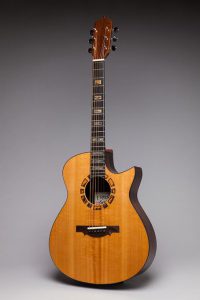An interesting attempt to firm up the line between folklore and fact.
May, 2015
I want to tell you about a project I completed recently. In order to gain a better understanding of the tonal differences between cedar, European spruce, and Sitka spruce, I built three identical guitars that differed ONLY in the use of these soundboard woods. Backs and sides, gluing and assembly techniques, bracing, ornamentation, tuners, finish, and voicing were the same. (Technically, there was one difference besides the choice of topwood: the mosaic inlays on each of the instruments were of different colors; but I don’t think this affected sound in any way.)
The project began in 2012 when a client (who prefers to remain anonymous) bought a classical guitar from me. In the course of subsequent discussions we began to talk about a steel string guitar commission. This individual is genuinely interested in the ins and outs of guitars, guitar making, music, and sound; and he asked me a lot of questions and he patiently listened to my various answers. It eventually led to a conversation about the characteristic sound of one wood versus another… and how difficult it was to pin down those factors when comparing one maker’s work to another’s — or even two guitars built in different years that might or might not have structural or design differences significant enough to affect sound. There are too many building techniques and variables. So we began to consider the possibility of a multiple build that focused on keeping every variable — except for the choice of topwood — constant.
As far as we knew nothing like this had been done before. It would be a tricky challenge to keep everything else constant; it cannot be done in a factory setting because the ideal in that environment is dimensional consistency. And when it comes to sound, woods that are the same size/thickness/height do not predictably yield identical density, stiffness, or vibrational action. Especially if the woods are of different species.
So, the selection of materials and the construction of the soundboxes needed to be carried out with a hand, an eye, an ear, techniques, working conditions, back-and-side woods, voicing procedures, tap tones, etc. that promoted consistency. That was going to be my contribution. And after that, we would need a competent player with a sensitive touch and a discerning ear to evaluate the performance of such instruments. We both thought to ask Michael Chapdelaine, who is in our opinion second to none as a guitar player, to do this.
Finally, in order to make the resulting information available to others in a meaningful way, it seemed obvious that this ought to be written up and even accompanied by a videotape and high quality audio recording of the experience.
I am writing this up in the form of a two-part article that will appear as two chapters in my forthcoming book — with links to a website that will give access to both the visuals and the audio — so that anyone who is interested can read our comments and opinions of these guitars’ sounds, see how the tests were carried out, and also hear the guitars directly. It should be interesting.
I have been writing a second book. It is an outgrowth and continuation of my first two-volume work which is about the ins and outs of the contemporary guitar. I’m having trouble containing my writings to a single volume under a single umbrella title, though. Some of what I’ve been writing about is technical, and some is more personal, reflective, and biographic… and the material is altogether too wide-ranging to fit comfortably under one title. I mean, who wants to read about an author’s personal ups and downs in a how-to or method book? I’m pretty sure that titling this “a luthier’s further reflections on the guitar” or something like that will sound terminally boring. So, as with my last book project, this one will likely morph into a two-volume set. I’m thinking of titling these books as Guitar Making: Some of the Fine Points and A Luthier’s Life, respectively. Those titles seem more fitting than any one name I can think up.
Anyway, the prospect of getting a more scientifically-based handle on the contributions to sound of different topwoods has been an interesting one. I just thought I’d give you a heads-up on this one.

Sitka Spruce Top |

Cedar Top |

European Spruce Top |